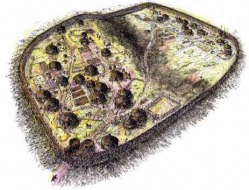Iron Age

The clearest iron age evidence in the villages is the Hill Fort atop of what is today known as Grafton Hills.
The reason for the location of the Hillfort is obvious: this is easily the highest point for some distance. However what is not so obvious is what exactly did the structure consist of.
Most Hillforts provided a tribal centre which was primarily economic or political in nature, in a similar way as their medieval fortified manors and castles would in the middle ages.
The forts would become in turn markets, refuges, cattle grazing, storage points, courts, councils and the centre of local government. The self appointed Lords, tribal leaders and other pillars of the community would sit in positions of assumed great power, surrounded by their favourites, all of whom would revel in their self indulgent, priviledged status in local society. How different to today this must have been!
It is by no means clear that the hill fort in Marton Cum Grafton was a hill fort in the accepted sense of the word, as it appears too small to carry out the functions that such a structure would usually have been expected to perform: given that for some reason the fort has been utterly removed by quarrying means that it is unlikely we will ever know the full story.
A tiny section of the area was excavated in the late 1930's. There were disapointingly few finds and no features such as ditches and embankments. These would have given some clue as to the extent and purpose of the fort. The full excavation report, dated 1950, is here.
Ultimately the finds were of late iron age/ early roman in origin, and generally of poor quality. Sadly they appear to have vanished into the depths of Harrogate Museum, who are unable to locate them.
The excavation report C 1950 is available, but the excavated area is not easily located. The report actually stops short of identifying the area as a hill fort. The excavation took place in and around the area currently covered by the cricket field.
The location is a significant one, being not only the highest for some distance but also less than half a mile from the York to Aldbrough Roman Road, where a Milestone was found. (See Romans Section).
The site was excavated but unfortunately the area left undisturbed by the gravel works was very limited which, combined with the depth at which objects were found, (some 11 feet) meant that only a limited excavation could be carried out.
Essentially the excavators found much evidence of burnings, large amounts of animal bone and a considerable amount of fragmentary pottery. This was interpreted as an area of intensive (domestic) occupation.
A hearth with the remains of burnt material was also identified.
Above all of this was a layer of soil which appeared to represent a Roman period occupation layer. This was evidenced by the presence of Romano Brittish pottery types, as well as indications of building materials of similar dates.
It is clear that there is evidence of continuing occupation of the area from the Iron Age or slightly earlier into at least the second century AD.
Sadly the exact site of the excavation is today difficult to locate, but the “Black Layer” referred to in the report can apparently be seen in a number of locations associated with the Hill Fort. A fuller investigation of the site, with the objective of identifying any remaining Bronze age/Iron age features, as well as pinpointing the exact excavation site, is planned for 2008. The full excavation report is available to download HERE as a PDF.
Next (Roman)
